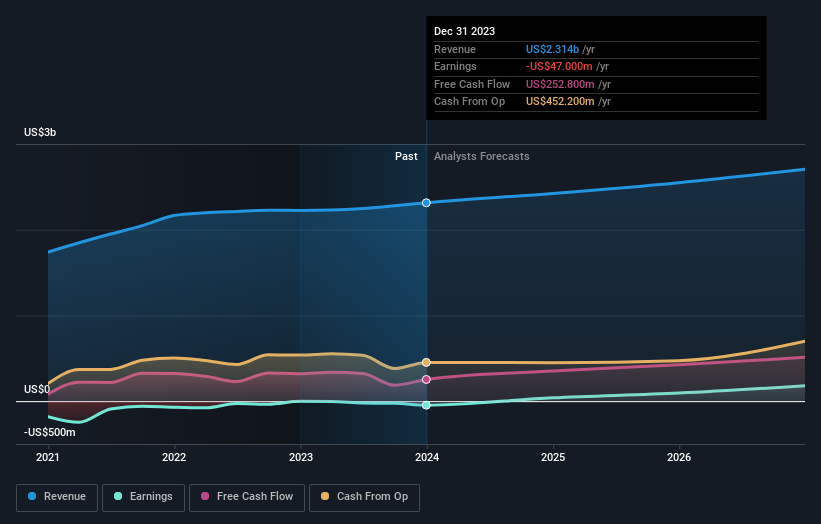Analyst Estimates: Here's What Brokers Think Of Dun & Bradstreet Holdings, Inc. (NYSE:DNB) After Its Annual Report
Dun & Bradstreet Holdings, Inc. (NYSE:DNB) shareholders are probably feeling a little disappointed, since its shares fell 3.7% to US$10.68 in the week after its latest annual results. It was a pretty bad result overall; while revenues were in line with expectations at US$2.3b, statutory losses exploded to US$0.11 per share. Following the result, the analysts have updated their earnings model, and it would be good to know whether they think there's been a strong change in the company's prospects, or if it's business as usual. We've gathered the most recent statutory forecasts to see whether the analysts have changed their earnings models, following these results.
See our latest analysis for Dun & Bradstreet Holdings
Taking into account the latest results, the most recent consensus for Dun & Bradstreet Holdings from eleven analysts is for revenues of US$2.42b in 2024. If met, it would imply a satisfactory 4.7% increase on its revenue over the past 12 months. Dun & Bradstreet Holdings is also expected to turn profitable, with statutory earnings of US$0.072 per share. Yet prior to the latest earnings, the analysts had been anticipated revenues of US$2.41b and earnings per share (EPS) of US$0.10 in 2024. So there's definitely been a decline in sentiment after the latest results, noting the pretty serious reduction to new EPS forecasts.
The consensus price target held steady at US$14.50, with the analysts seemingly voting that their lower forecast earnings are not expected to lead to a lower stock price in the foreseeable future. Fixating on a single price target can be unwise though, since the consensus target is effectively the average of analyst price targets. As a result, some investors like to look at the range of estimates to see if there are any diverging opinions on the company's valuation. The most optimistic Dun & Bradstreet Holdings analyst has a price target of US$18.00 per share, while the most pessimistic values it at US$11.00. These price targets show that analysts do have some differing views on the business, but the estimates do not vary enough to suggest to us that some are betting on wild success or utter failure.
Looking at the bigger picture now, one of the ways we can make sense of these forecasts is to see how they measure up against both past performance and industry growth estimates. We would highlight that Dun & Bradstreet Holdings' revenue growth is expected to slow, with the forecast 4.7% annualised growth rate until the end of 2024 being well below the historical 10% p.a. growth over the last five years. By way of comparison, the other companies in this industry with analyst coverage are forecast to grow their revenue at 6.4% per year. Factoring in the forecast slowdown in growth, it seems obvious that Dun & Bradstreet Holdings is also expected to grow slower than other industry participants.
The Bottom Line
The biggest concern is that the analysts reduced their earnings per share estimates, suggesting business headwinds could lay ahead for Dun & Bradstreet Holdings. Fortunately, the analysts also reconfirmed their revenue estimates, suggesting that it's tracking in line with expectations. Although our data does suggest that Dun & Bradstreet Holdings' revenue is expected to perform worse than the wider industry. The consensus price target held steady at US$14.50, with the latest estimates not enough to have an impact on their price targets.
With that said, the long-term trajectory of the company's earnings is a lot more important than next year. We have forecasts for Dun & Bradstreet Holdings going out to 2026, and you can see them free on our platform here.
We don't want to rain on the parade too much, but we did also find 2 warning signs for Dun & Bradstreet Holdings (1 makes us a bit uncomfortable!) that you need to be mindful of.
Have feedback on this article? Concerned about the content? Get in touch with us directly. Alternatively, email editorial-team (at) simplywallst.com.
This article by Simply Wall St is general in nature. We provide commentary based on historical data and analyst forecasts only using an unbiased methodology and our articles are not intended to be financial advice. It does not constitute a recommendation to buy or sell any stock, and does not take account of your objectives, or your financial situation. We aim to bring you long-term focused analysis driven by fundamental data. Note that our analysis may not factor in the latest price-sensitive company announcements or qualitative material. Simply Wall St has no position in any stocks mentioned.

